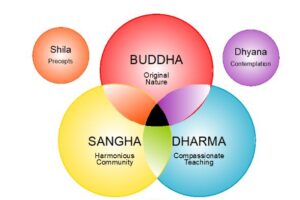
THE TRUTH IS ALREADY TRUE — PART ONE
Currently we are witnessing a presidential impeachment trial, only the third in the history of the United States. Ostensibly a process of getting at the truth of the matter, it is also a process of obfuscating the truth, deflecting or distracting the attention of the jurors and judges from the truth, depending on whether you are the prosecution or the defense. As such, the presentation is a stark example of the old adage that if you have three people in the room, there will be an attacker, a defender, and a moderator, and the three roles will rotate through the three present. In other words, with two people you can have a true collaboration, but with three you inevitably have politics.
The question of truth becomes one of objective versus subjective truth. And the evidence, via testimony, the paper trail of documents, and other hard evidence — such as the bloody long knives that brought down Julius Caesar — can likewise be the subject of endless dispute as to their veracity, or relevance. Trial lawyers can be forgiven for dissembling, raising smoke screens, and even lying in defense of their clients, as long as everyone agrees that the purpose of a trial has nothing to do with the truth. The adage that it is impossible to convince someone of the truth, if their paycheck depends on their not believing it, holds firm.
TRUTH IN ZEN
Zen Buddhism does not ignore the lamentable degree to which humankind can ignore, distort, or twist the truth to nefarious ends, but it points away from the disputatious truth of opinion to another kind of truth: the absolute reality, as opposed to our relative perception of it and conceptions about it.
In Zen, we regard the examination of truth to begin within the personal sphere, expanding to the social, natural, and ultimately universal spheres, as touched on in prior Dharma Bytes. Or you might prefer the model of physical versus emotional, mental, and social dimensions. Our meditation, zazen, promotes the development of balance, or Samadhi, in all of these dimensions precisely because it is an exploratory process of discovery, not one of imposing a preconceived truth.
On a relativistic level, we may speak of physical, personal truth, which may differ in kind and expression from emotional and social truths, especially as we mature, and if we happen to visit or move to a foreign country, where cultural memes and societal truths are out of synch with those native to our origins. Mental truths, that are informed by percepts and defined by concepts, may not align with natural, or universal truths. Relative truths, which are primarily a matter of agreement — such as the meaning of language itself — may have little to do with the absolute truths from which they are derived. A “tree” does not know that it is a tree, let alone an “arbre” (French), or “ki” (Japanese).
MODELING TRUTH IN BUDDHISM
Another useful model in considering the complexity of the truth that we examine in Zen is that of the Five Aggregates (S. skandhas) — of form, or appearance; feeling, or sensation; thought, or perception + conception; mental formations, or motive and impulse; and consciousness, or awareness — the five divisions of the holistic truth of a sentient being. That is, the truth of which we can be conscious manifests as the appearance of material form; the experience of sensory data; the perception of self and other and conceptions of reality that derive from that; the underlying drives, conscious and unconscious, of the psyche, and ultimately the self-awareness of consciousness itself.
The other Buddhist teachings point to other aspects or dimensions of this preexistent truth – the Four Noble Truths laying out the fundamental principles of inexorable change, which from a human perspective renders existence unsatisfactory, or suffering (S. dukkha), and prescribes the abandonment of our craving in order to arrive at the cessation of our suffering, including our craving for the truth, one would suppose. The Noble Eightfold Path articulates the kinds of behaviors (Right Conduct) and practices, both physical and mental (Right Discipline) that we are to undertake to accede to the kind of view and understanding (Right Wisdom) that Buddhism proposes is in alignment with reality. This is coming to accord with our teachers, coming into harmony with the Way of Taoism, and embracing the Bodhisattva Vow of compassionately helping all others to cope with their own confrontation with this incessant and unrelenting reality.
The Twelvefold Chain of Interdependent Origination provides another model of how we got to be in the situation we are in, the Six Parmitas another for what we can do about it, perfecting the practice of Generosity, Patience, Energy, Forbearance, Meditation, and Wisdom, the sum total of degree of completion of the other five.
SIMPLICITY VS. COMPLEXITY
Thus, Zen does not shy away from the overwhelming complexity of the truth that we are confronting as human beings. But it proposes that the approach to resolving and reconciling ourselves to that truth is very simple in concept, if difficult in execution. Zen recommends simply sitting still enough, for long enough, and trusting your original mind. In this process, simple in principle but difficult in execution, we will eventually see through our misconceptions, which are mostly preconceptions, and enter into the truth directly.
Zen Buddhism differs from philosophies and religions mainly in this action-oriented approach to the apprehension of truth. We are to “fully examine in practice,” to use one of Master Dogen’s favorite phrases, any and all aspects of our understanding. It is not enough to study and compile theories and models of the truth. We must find it for ourselves in our experience.
Truth is a slippery commodity. There are innumerable quotes that illustrate this truth about truth, such as the famous line of Jack Nicholson’s movie character in A Few Good Men, “You can’t handle the truth!” The truth of Zen is something like this. It cannot be reduced to ordinary understanding. Even Buddha did not understand it. He taught by examining and expounding upon how our mind works in apprehending, or distorting, the truth. He recommended that his listeners not take his word for it, but work it out in their own meditation. Do thou likewise. The unexamined life is not worth living, as attributed to Socrates.
NOT THIS NOT THAT
The primary way that we begin and continue this examination of truth is to question our own assumptions about it. As the great Danish philosopher Soren Kierkegaard reminds us:
There are two ways to be fooled. One is to believe what isn’t true; the other is to refuse to believe what is true.
The first is the starting point in Zen. We take vows and receive precepts in initiation and other ceremonies, which raise the question of our own innate, perhaps subliminal precepts – those beliefs underlying our world view (mental formations). When we raise these to the level of conscious awareness, the social and personal tenets which are the operating basis of our behavior, we may find them lacking, especially when compared to the refined Precepts of Zen Buddhism. When we see that our past behavior and its consequences (karma) are based on “beginningless greed, hate and delusion,” and “born of body mouth and mind,” we can begin to divest ourselves of such attachments and aversions, recognizing that they come with the territory of being a sentient being. We did not make them up.
To Kierkegaard’s second point, in Zen we are not asked to believe what is true, i.e. based on doctrine, but to find it out for ourselves, suggesting that Buddha’s truth will be confirmed by our own, unfiltered experience, particularly in zazen. In expounding a worldview based on such inconvenient truths as impermanence, imperfection, and insubstantiality, Buddha realized that his teachings would not be popular. They inveighed against comfortable beliefs in a self-existent self, or soul (S. atman), the promise of reincarnation, and, in modern times, they challenge the hope of surviving death and spending eternity in heaven. But they also mitigate against the Damocles sword of impending doom in eternal perdition in hell.
NO PREFERENCES
So the search for truth requires the abandonment of certain biases and prejudices that are a natural part of our mode of operation as sentient beings. As the great sage of China, third Ancestor Sengcan, assures us (Hsinhsinming, “Trust in Mind)”:
The great Way is not difficult for those who have no preferences
Absent both love and hate everything becomes clear and undisguised
The smallest distinction however sets heaven and earth infinitely apart
Here he is saying that following the great Way, not merely understanding it, is not that difficult, as long as we eschew preferences. Love and hate indicate the polar nature, depth and intensity of those preferences — not merely a hankering for chocolate over vanilla ice cream — though the “smallest distinction” may seem to imply a trivial level of discrimination. That heaven and earth are set infinitely apart may likewise suggest that heaven is another place, while life on earth is separate. But what is implied here is that heaven and earth need not be apart, that samsara can indeed become nirvana, but for our making distinctions. This may be taken to be akin to the early Christian teachings of the Garden of Eden, and the Fall from Grace of Adam and Eve, by eating of the Tree of the Knowledge or Good and Evil. If good and evil are indeed in the eye of the beholder, then the removal of that mote of dust is the essential task of spiritual awakening.
IT IS WHAT IT IS
Truth is, unfortunately, one of those terms cavalierly bandied about, often with careless abandon, by those who profess to possess it. But the truth is already true, whether we know it or not. This may seem to belabor the obvious. But in the current cultural context in which the very meaning and reliability of truth, particularly in public discourse, is under threat, it is worthwhile considering what we mean by “the truth,” especially as regards the deeper meaning of our existence.
In Zen, even truth is not exempt from dualistic thinking. Thus we have absolute and relative truth, Truths with capital and lower-case t’s, respectively. We have many relative truths, but only one absolute truth. And the latter does not depend upon our apprehending it, in order for it to be true. The most famous formulation of this teaching in Zen is “Form is Emptiness, Emptiness is Form.” All such teachings point to the non-duality behind the duality, the mystery underlying the appearance. The Tao te Ching contains the formulation:
Caught by desire we see only the manifestation
Free from desire we confront the mystery.
Zen’s final answer is a deeper mystery. As Dogen mentions, finally we are left with ambiguity.
Zen’s Form (appearance) and Emptiness (essence) may be “understood” (again, even Buddha did not understand it) as somewhat analogous to matter and energy as in Einstein’s E=MC2 formula. The philosopher-engineer R. Buckminster Fuller described matter as “impounded” energy — that is, radiant energy in thrall to gravitational or other forces, restrained by it to a limited orbit. Examples include celestial bodies as well as cosmic particles, which, though vastly different in terms of mass, are alike, each falling through a specific curving arc (geodesic) in spacetime, reflecting the sum total of all the various forces acting upon them. The same may be said of the clusters floating in yesterday’s dishwater – clumped together by electrostatic attraction.
Similarly, though we think we well know the appearance of our ordinary reality through the evidence of our senses, it is only in the context of hidden forces acting upon it, such as Buddha’s insistence that our (discriminating) mind imposes a “false stillness” upon reality. For the essential reality to manifest, we must enter into an awareness of change on a whole different level, moment by moment. But in Zen, this moment is fleeting faster than an arrow. This dynamic at the root of existence is one meaning of Buddhist Emptiness: ever-changing.
SEEING INTO THE FLUX
Master Nagarjuna, 14th Ancestor in India, defined Zen insight as “seeing into the flux of arising, abiding, changing and decaying” (attribution lost). The confusing part is the “abiding.” Although we know that everything is constantly changing, things seem to stay the same, at least for the moment. This flux is not a description of something we can “see” in the sense that we can register it consciously, but rather in the sense of “I see what you mean.” However, it must be a declaration of the true condition of things; that is, change definitely exists as the state of change. But it fluctuates at such a rapid rate that we cannot witness it. Nonetheless we must be experiencing it simultaneously in all the senses, not just vision. We notice the changing of the seasons and other longer-term, apparently repeating, patterns.
The fundamental frequency of change, or the minutest unit of time, is called a “ksana” in Sanskrit. I think of it as the “refresh rate” of reality, a micro-second in time. This does not mean that time is a tangible entity, however, or another linear dimension, like the theoretical Cartesian x-y-z dimensions of space. Nor does it imply that time has an arrow of directionality, though eggs cannot be unscrambled.
Another problem in perceiving reality is that we are constantly distracted by the complex and relentless changes occurring both inside and outside of our bodies. But the fact that these subliminal changes are transpiring, whether we know it or not, indicates that whatever we do register consciously may be regarded as a kind of harmonic, like overtones and undertones in music, or the ringing of a gong. Any and all such sensory changes in perception must be resonances on the ksana, or fundamental frequency, whether or not our internal nervous system can ever speed up (or slow down) enough to sense them directly, i.e. to come into harmony.
FINE-TUNING MIND
When we sit in Zen, with increasing stillness we begin to notice these changes in our sensory surround: seeing light, color and motion where ordinarily we do not; hearing sounds of higher and lower frequencies when we are ordinarily unaware of their presence; and feeling sensations of motion and tactility on different scales. We usually adapt to continuous stimuli, and thus they do not register consciously. When we come to the central experience of “stillness-in-motion-and-motion-in-stillness” (J. mokurai), is when we are closest to being in tune with it. As Dongshan Liangjie (J. Tozan Ryokai), 9th Century founder of Soto Zen in China, asserted in “Hokyo Zammai – Precious Mirror Samadhi,” over 1000 years ago:
So minute it enters where there is no crack
So vast it transcends dimension [but]
A hairsbreadth deviation and you are out of tune
Like tuning an old analog radio dial, if you are off the frequency the slightest degree to one side or the other, you get nothing but static.
But we should not assume that we can intentionally tune our mind-dial to the basic frequency of existence merely by wishing it were so, or striving through might and main. From the same verse in Fukanzazengi:
Now when you trace the source of the Way
You find that it is universal and absolute
How can it be dependent upon practice and enlightenment?
The “source of the Way” may be taken as synonymous with the Absolute Truth for our purposes; or, if you will, the fundamental intent of existence itself. If the Truth is indeed universal and absolute, there is no need to undertake a spiritual quest to foreign lands (as Dogen himself famously did), or venture anywhere other than where we find ourselves in spacetime.
Nor can there be anything special we can do, i.e. zazen, to enter our preexistent reality. The truth that Buddhism points to certainly cannot depend upon our practice of Zen and zazen, nor achieving some special state — “enlightenment” — in order to manifest as it is. But in order to trace its source, we must assume that we do not yet have it. A corollary confusion that might set in is that the Truth is dependent upon our efforts in attempting to ferret it out, the exclusive property of humanity.
The “source of the Way” may also be interpreted to include the meaning of all of existence, if not its first cause, either in the sense of God’s intent, or the Big Bang. In theistic religions, the source is a who — namely God. In science and philosophy, it is a how or a why — when did it all begin and where will it end? But in Zen, it is a what — what is the meaning of this, and our place in it?
In any case, when you trace it directly — through the immediacy of Zen’s method, zazen — you find that there is no place where the truth is not already true, and there are no shadings, no relativity to it. If true, it is absolutely true everywhere in the universe. This is one way of understanding what makes the Noble Truths noble. Like the noble gases, they are inert: they do not change with proximate causes and circumstances. The Truth, with a capital T, certainly does not depend on what we do about it. It is what it is.








